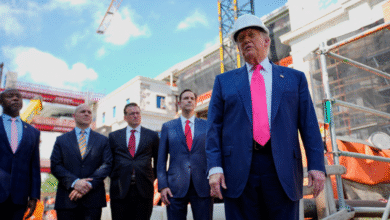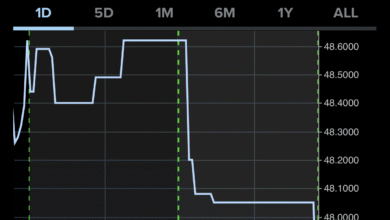BTCS Ethereum Holdings Surpass $270 Million Post Offering

BTCS Ethereum holdings have reached impressive new heights, surpassing $270 million thanks to the company’s recent convertible note offering. On July 18, 2025, BTCS Inc., a leading blockchain technology firm, successfully raised $10 million through convertible notes, priced significantly above its stock value, demonstrating robust investor confidence. The strategic acquisition of 14,240 Ethereum (ETH) brought its total to 70,028 ETH, further solidifying its position in the rapidly growing DeFi landscape. This influx of capital not only enhances the company’s Ethereum treasury but also aligns with its core strategy of DeFi/TradFi Accretion in the blockchain infrastructure sector. As BTCS continues to navigate the complexities of blockchain investments, the impressive growth of BTCS stock price is poised to attract even more attention from investors looking for opportunities in this innovative market.
In recent developments, BTCS Inc. has positioned itself as a key player in the digital currency ecosystem, particularly through its substantial Ethereum reserves. The company’s successful convertible note offering is a significant milestone, signaling strong market interest and commitment to strengthening its cryptocurrency portfolio. By increasing its Ethereum treasury, BTCS not only bolsters its asset base but also enhances its capabilities within blockchain technology and decentralized finance (DeFi). This growth strategy underlines the firm’s focus on blending traditional financial approaches with digital innovation, paving the way for further advancements in blockchain infrastructure. As BTCS continues to expand its Ethereum holdings, it remains a noteworthy example of how companies in the traditional finance space can thrive amid the technological shift towards decentralized financial systems.
BTCS Ethereum Holdings: A Strategic Asset
BTCS Inc. has significantly bolstered its Ethereum holdings, now valued at over $270 million following a recent uptick in acquisitions. The company has strategically acquired 14,240 Ethereum (ETH), raising its total reserves to 70,028 ETH. With Ethereum prices soaring around $3,850, this strategic increase not only adds to the company’s asset base but reinforces its commitment to capitalize on the potential appreciation of this leading cryptocurrency. As the blockchain landscape evolves, holding substantial ETH positions allows BTCS to leverage emerging trends in decentralized finance (DeFi) and continue its growth trajectory in the public markets.
The decision to enhance its Ethereum treasury aligns with BTCS’s core strategies aimed at integrating decentralized finance with traditional financial systems. By increasing its Ethereum holdings, BTCS positions itself at the forefront of innovations in blockchain infrastructure. Moreover, their approach emphasizes not just accumulation but also the potential for generating revenue through staking and block building initiatives. This dual focus on asset accumulation and operational enhancement illustrates BTCS’s vision of becoming a pivotal player in the DeFi/TradFi integration.
Unlocking Capital Through Convertible Note Offering
Recently, BTCS completed a $10 million convertible note offering, setting a premium price of $13 per share—a striking 198% over the stock’s closing price. This financial maneuver is part of a broader strategy to fortify its capital base amid fluctuating market conditions. Convertible notes provide a flexible financing option that allows the company to raise money while potentially minimizing immediate cash outflows. This approach has not only enabled BTCS to bolster its Ethereum treasury but also supports its ongoing blockchain infrastructure initiatives.
The proceeds from the convertible note offering, along with recent ATM stock sales totaling $1.64 million, reflect BTCS’s strategic focus on diversified capital raising strategies. By harnessing multiple funding sources, including equity sales and borrowing from DeFi platforms like Aave, the company enjoys a robust capital influx. This resourcefulness is crucial for scaling operations, hiring talent, and investing in emerging blockchain technology, all vital components for maintaining competitive advantages in today’s dynamic financial landscape.
Emphasizing their strategy, CEO Charles Allen noted that this influx of capital is not just about accumulating assets but also about deploying those assets strategically to enhance blockchain operational efficiencies. The successful funding of initiatives like staking and node operations aligns perfectly with BTCS’s overarching philosophy of fostering sustainable growth within the evolving DeFi space.
Navigating the DeFi and TradFi Landscape
BTCS Inc. articulates a clear vision of bridging decentralized finance (DeFi) with traditional finance (TradFi) through what it calls the “DeFi/TradFi Accretion Flywheel.” This innovative framework aims to leverage the synergies between both worlds to maximize value creation. By incorporating Ethereum into its core offerings and utilizing blockchain technology, BTCS enhances its operational efficacy and paves the way for a more inclusive financial ecosystem. This strategy is particularly relevant as institutions and individual investors alike begin to recognize the benefits of integrating cryptocurrency assets into their portfolios.
Moreover, BTCS’s efforts to grow its Ethereum treasury are complemented by sophisticated initiatives aimed at generating income through evolving DeFi services. As the company increases its Ethereum holdings and develops operational capacities like NodeOps and Builder+, it positions itself as a leader in the crypto asset space. This responsive and adaptive strategy not only appeals to current investors but also attracts those interested in the transformational potential of blockchain, thereby enhancing BTCS’s stock reputation in the competitive marketplace.
Impact of BTCS Stock Price on Market Position
The value of BTCS’s stock is intricately linked to its operational strategies and financial maneuvers, including the convertible note offering and the expansion of its Ethereum holdings. As such, the company’s strategic choices directly influence investor perception and stock pricing, determining their value proposition in the crowded cryptocurrency market. Investors are particularly attentive to movements in BTCS stock because they understand that as the company increases its blockchain assets, its valuation can be expected to rise correspondingly. Thus, a strong stock price often reflects confidence in the company’s direction and its ability to execute on strategic goals.
Since the closing stock price was set at a premium during the convertible note offering, it signals to the market that BTCS is on a growth trajectory, further attracting new investors looking to gain exposure to Ethereum assets. This sentiment can create a positive feedback loop, enhancing market interest in BTCS stock as the firm continues to expand its already substantial Ethereum treasury while simultaneously optimizing its blockchain infrastructure. Therefore, understanding the interplay between BTCS stock price and operational advancements is essential for both investors and market analysts looking to gauge the company’s future prospects.
Future Growth Prospects for BTCS
BTCS’s strategic acquisition of Ethereum exemplifies its dedication to future growth within the burgeoning blockchain sector. The recent capital influx, including proceeds from the convertible note and ATM sales, not only enhances their treasury but also lays a solid foundation for further investments in infrastructure and operations. As the adoption of decentralized finance accelerates, the potential for revenue generation through staking and block building becomes increasingly viable.
Moreover, with the evolving landscape of blockchain technology, BTCS is well-positioned to capitalize on new opportunities. Their commitment to the DeFi/TradFi convergence suggests that they are not just prepared to meet current market demands but also to adapt to future trends. As the cryptocurrency ecosystem matures, companies like BTCS that focus on robust operational frameworks and diverse revenue streams will likely emerge as leaders in the space, driving sustained growth and shareholder value.
Capitalizing on DeFi Innovations
The rise of decentralized finance has opened up a myriad of opportunities for companies like BTCS, which leverages DeFi innovations to enhance its profitability and operational capacity. By utilizing platforms such as Aave for borrowing and staking ETH, BTCS can maximize returns on its blockchain investments. This innovative approach not only provides liquidity but also incentivizes the company’s aggressive growth strategy, making BTCS a compelling investment option for those looking to capitalize on the DeFi wave.
In addition, DeFi platforms offer an agile infrastructure for companies to interact with a wider array of financial products and services. BTCS is keenly aware of the transformative effects these innovations can have on the traditional finance ecosystem, and as such, positions itself to attract both retail and institutional investors. As a result, embracing DeFi is not simply about participation; it is about leading a sector gaining worldwide traction while ensuring robust financial returns for stakeholders.
Market Dynamics and Investor Sentiment Around BTCS
Understanding market dynamics is crucial for comprehending the valuation and stock performance of BTCS. The company’s proactive approach to capital accumulation and its substantial Ethereum holdings can have a direct impact on investor sentiment. A positive outlook on the cryptocurrency market often boosts confidence in BTCS’s prospects, leading to potential stock price increases. On the other hand, fluctuations in Ethereum prices or regulatory uncertainties might pose risks that investors must consider.
investor sentiment plays a pivotal role in shaping the market’s perception of BTCS stock. This sentiment is influenced not just by the company’s financial strategies, such as convertible note offerings, but also by broader industry trends. As the cryptocurrency market matures, companies that display resilience and adaptability, like BTCS, are likely to garner investor trust. Thus, understanding how external factors influence investor expectations is critical for evaluating BTCS’s future stock performance and growth trajectory.
The Role of Blockchain Infrastructure in BTCS Strategy
In the blockchain ecosystem, the importance of robust infrastructure cannot be overstated, and for BTCS, this is central to its operational strategy. The company recognizes that by investing in blockchain infrastructure, it can streamline transactions, enhance security, and ultimately boost efficiency in operations. As blockchain applications gain traction across various sectors, having a solid infrastructure will position BTCS as a reliable player in this competitive space.
Moreover, BTCS’s focus on infrastructure development complements its ambitions to expand its Ethereum holdings. By creating an integrated operational framework that supports both financial applications and the growth of its Ethereum treasury, BTCS seeks to provide unique value to its stakeholders. This infrastructure not only supports the company’s income-generating activities through DeFi services but also strengthens its overall market position in a rapidly evolving digital financial landscape.
Long-term Vision of BTCS in the Ethereum Space
BTCS’s long-term vision encapsulates its commitment to becoming a leader in the Ethereum space while fostering an inclusive financial ecosystem through the integration of DeFi solutions. The company’s strategy of accumulating Ethereum positions it favorably to benefit from potential market expansions and technological advancements. As Ethereum remains at the forefront of smart contracts and decentralized applications, companies like BTCS stand to gain significantly by aligning their initiatives with these trends.
With their vision anchored in leveraging Ethereum’s capabilities, BTCS aims to create innovative pathways that not only enhance its treasury but also contribute positively to the market dynamics. Tech-savvy investors are likely to view BTCS’s focus on Ethereum as a critical factor in its potential for long-term growth. Thus, the company is not only investing in a cryptocurrency but is also betting on the future of decentralized technologies, further solidifying its role in the ongoing financial transformation.
Frequently Asked Questions
What is the current status of BTCS Ethereum holdings?
BTCS Inc. has significantly increased its Ethereum holdings, now valued at over $270 million. The firm holds a total of 70,028 Ethereum (ETH) following a recent acquisition of 14,240 ETH.
How has BTCS financed its increase in Ethereum treasury?
BTCS raised funds through a $10 million convertible note offering, alongside proceeds from common stock sales under its ATM program. This financial strategy is aimed at expanding its Ethereum treasury and enhancing blockchain infrastructure.
What does the term ‘DeFi TradFi Accretion’ mean in relation to BTCS?
BTCS’s ‘DeFi TradFi Accretion Flywheel’ strategy focuses on combining decentralized finance (DeFi) and traditional finance (TradFi) methods to accumulate Ethereum holdings and generate revenue through operations like staking and block building.
What impact does the BTCS stock price have on its convertible note offering?
The convertible notes were priced at $13 per share, which is a 198% premium over BTCS’s stock price at closing on July 18, 2025. This high premium reflects the company’s strong position in the market as it raises capital to enhance its Ethereum holdings.
How does BTCS plan to utilize the capital raised from its recent financial activities?
The capital raised, amounting to approximately $207 million year-to-date, will be used to expand BTCS’s Ethereum treasury and support the development of its blockchain infrastructure, aligning with its growth strategy in the cryptocurrency market.
What is the significance of the Ethereum price for BTCS’s holdings?
BTCS’s total Ethereum holdings are valued at around $270 million based on an ETH price of $3,850. Fluctuations in the Ethereum price directly influence the company’s asset valuation and capital strategy.
What operations underlie BTCS’s blockchain infrastructure development?
BTCS focuses on various operations, including NodeOps for staking Ethereum and Builder+ for block building, which are essential components of its strategy to enhance blockchain infrastructure while accumulating Ethereum.
How does BTCS’s acquisition strategy impact its position in the cryptocurrency market?
By actively acquiring Ethereum and utilizing innovative financing methods, BTCS positions itself as a leading entity in the public markets, aiming to be one of the most leveraged Ethereum opportunities available.
| Key Points |
|---|
| BTCS Inc. completed a $10 million convertible note offering. |
| Raised Ethereum holdings to over $270 million by acquiring 14,240 ETH, totaling 70,028 ETH. |
| Convertible notes priced at $13 per share, a 198% premium over the stock’s price on July 18, 2025. |
| Sold 271,580 common shares for $1.64 million at $6.04 per share under the ATM program. |
| Year-to-date, BTCS raised approximately $207 million from various financing methods. |
| Core strategy focuses on accumulating ETH and generating revenue through staking and block building. |
| CEO Charles Allen emphasized actively deploying capital for Ethereum treasury expansion and blockchain ops. |
Summary
BTCS Ethereum holdings have reached an impressive value of over $270 million following a significant $10 million convertible note offering. The company’s strategy, which involves leveraging diverse financing methods to accumulate more ETH, positions them as a key player in the blockchain market. With a focus on enhancing its Ethereum treasury and overall infrastructure, BTCS is paving the way for future growth in the dynamic cryptocurrency landscape.




